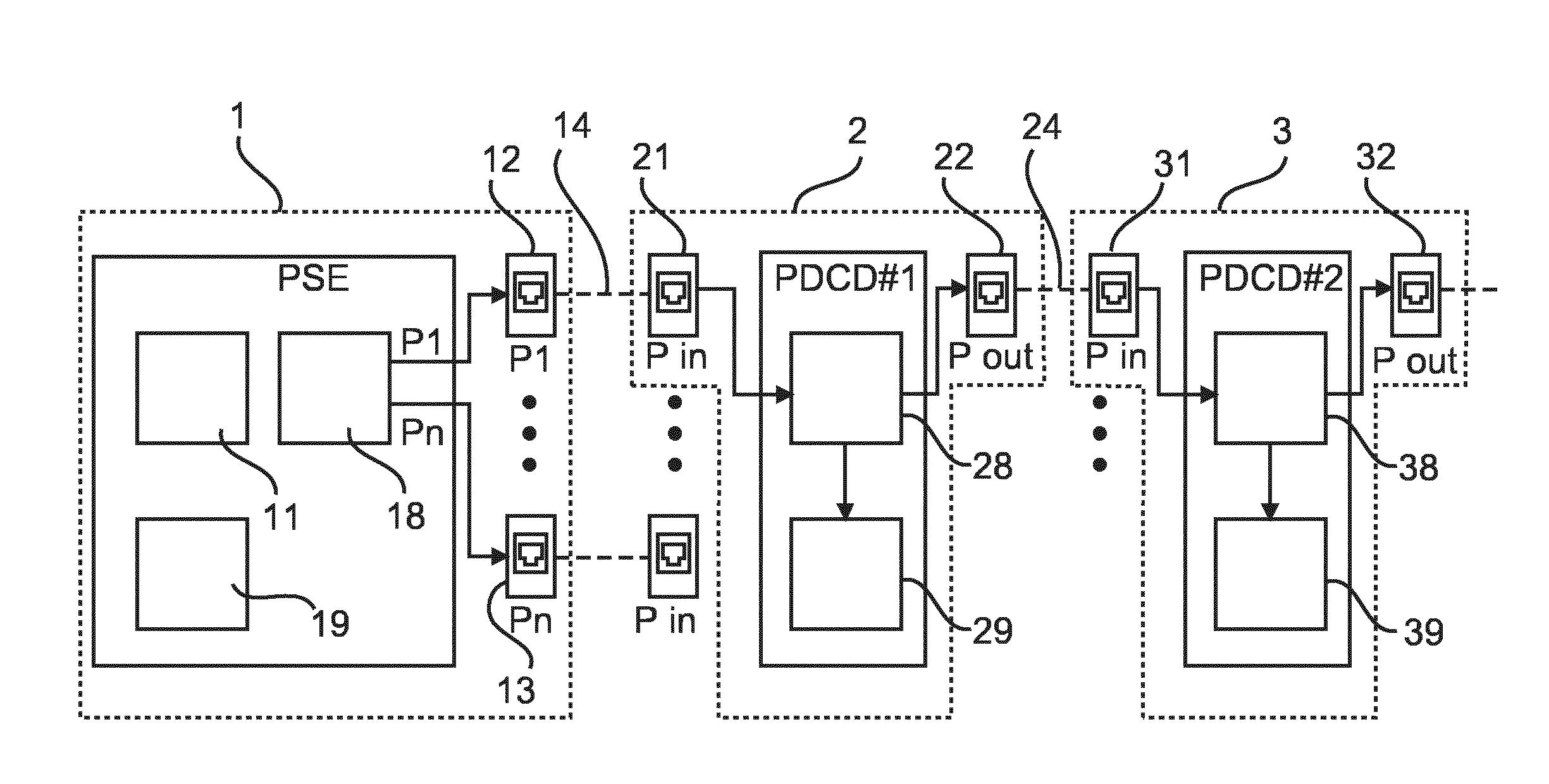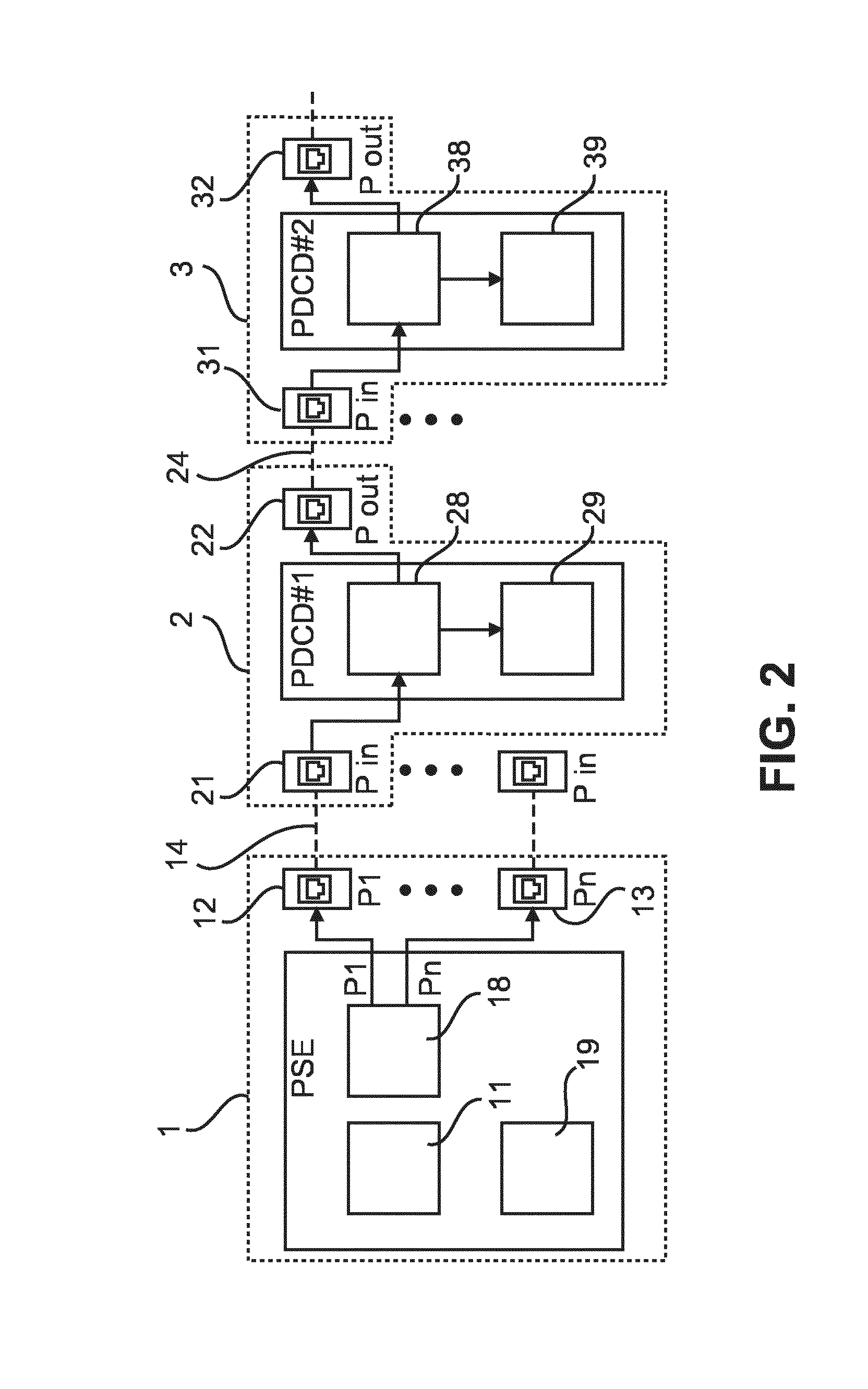Power negotiation in daisy-chained systems
a power negotiation and daisy chain technology, applied in the direction of power supply for data processing, instruments, computing, etc., can solve the problems of insufficient communication and processing overload complexity, and achieve the effect of reducing connection requirements
- Summary
- Abstract
- Description
- Claims
- Application Information
AI Technical Summary
Benefits of technology
Problems solved by technology
Method used
Image
Examples
first embodiment
[0038]The above first embodiment provides the advantage that a simple power budget negotiation can be provided at all chain stages. Moreover, no hardware or software or protocol modifications are required at the PSE. The last-in-chain device can be a legacy PoE load. Hardware implementation of the PDCDs can be kept simple, esp. power supply logic, since they do not need to differentiate between full operation (load+chain controller) and stand-by operation (chain controller only).
[0039]The first embodiment can be enhanced in that each PDCD, starting with the first PDCD next to the PoE, initially only negotiates on its input port only the amount of power corresponding to its own power consumption plus a predefined power amount for one further device. This additional amount of power consumption may only be requested if it is detected by the chain controller that a further device is connected at the output port, e.g. by a physical connection. The additional amount may correspond e.g. to...
second embodiment
[0042]FIG. 4 shows a schematic block diagram which indicates steps of a power negotiation procedure according to a
[0043]Similar to the first embodiment, the first load device L1 (e.g. a spot lamp) claims in a first message or request Si maximum amount of available power and gives down-stream what remains reduces this issue. However, in the second embodiment, the device L1 does not switch on the load but powers only the processor (of the chain controller) in a first negotiation phase (initialization phase). So, even if for instance 20 load devices form a chain and their processing driving takes 100 mW each, only 2W will be consumed in the first phase in total and all processors get power. In the second phase the load devices of the chain or chain members signal upstream (i.e. towards the PSE) how much power they would like claiming.
[0044]Thus, during the initialization phase only the first load device L1 in the chain starts the negotiation (for the full power for the entire chain). T...
third embodiment
[0061]In the following, a third embodiment is described, where power negotiation is configured to prevent for long time delays when the first load device (e.g. lamp or luminaire) has to wait until the last load device is requesting power. This can also be used before the load devices are installed because it houses in the load device itself and the load devices can be provided with small amount of power, probably a battery or energy scavenger, to send the amount of power to be used by the load device.
[0062]According to the third embodiment, a power request value (indicating the amount of required power) is embedded or stored in the load device itself. Once the load device is attached to one or more neighbor devices (e.g. detected by discovering a physical connection on the upstream port), it gives this request number and the neighbor devices add this to their own request number. This is done until the connector to the PSE delivering the power is reached and then it is checked whethe...
PUM
 Login to View More
Login to View More Abstract
Description
Claims
Application Information
 Login to View More
Login to View More - R&D
- Intellectual Property
- Life Sciences
- Materials
- Tech Scout
- Unparalleled Data Quality
- Higher Quality Content
- 60% Fewer Hallucinations
Browse by: Latest US Patents, China's latest patents, Technical Efficacy Thesaurus, Application Domain, Technology Topic, Popular Technical Reports.
© 2025 PatSnap. All rights reserved.Legal|Privacy policy|Modern Slavery Act Transparency Statement|Sitemap|About US| Contact US: help@patsnap.com



